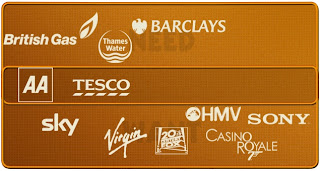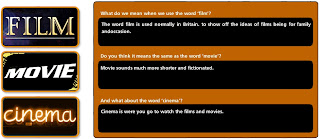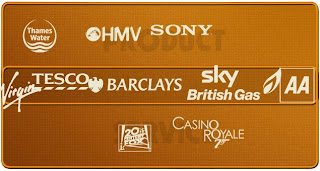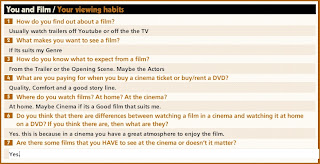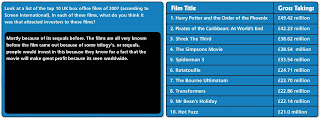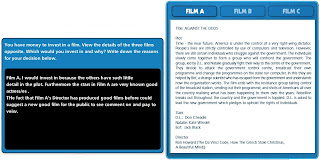Definitions and the Difference between...
Audience of Mar-mite.
Difference between a Product and a Service.
Above the Line - Part of budget reserved for major players in the productions such as the director, producers, writers, actors, etc. Everything else is below the line.
Aperture - A measure of the width of the opening allowing light to enter a camera.
Aspect Ratio - A measure of the relative sizes of the horizontal and vertical components of an image. AKA Academy Ratio.
Axis of Action - Also called the "180° line "is an imaginary line that passes through the two main actors of a scene, defining the spatial relations of all the elements of the scene as being to the right or left.
Abby Singer - The second-to-last shot of the day. Named after production manager Abby Singer, who would frequently call "last shot of the day." Also called the martini shot.
B-Movie- A low-budget, second tier movie often 2nd movie in a double-feature billing. B-films were cheaper for studios because they did not involve the most highly paid actors or costly sets movie theaters also like then because they draw in revenues while remaining cheap to bring in.
Background Artist– also known as matte artist is the person responsible for designing art in the rear of the set.
Backlot - A large, undeveloped area on studio property used for constructing large open-air sets.
Below-the-Line Expenses - All physical production costs not included in the above-the-line expenses, including material costs, music rights, publicity, trailer, etc.
Best Boy – Also called the Assistant Chief Lighting usually of the gaffer or key grip. In charge of the people and equipment, scheduling the required quantities for each day's work. The term originates from promoting the crew's 'best boy' to supervising.
Blocking – deciding where actors will move and stand so that lighting and camera placement can be set.
Blue Screen – Also known as green screen. Is a blue or green backdrop that actors are filmed in front of. Later the blank screen can be filled with digitally generated images to complete the background.
Boom Microphone - A long pole with a microphone on the end. Controlled by the "Boom Operator."
Bounce Board - A large white card made of foam or poster board used to reflect soft light.
Call Sheet - A listing of which actors will be required for which scenes, and when they will be required.
Cel - A hand drawn sheet representing a single animation frame, usually made of a clear material like cellulose.
Computer Generated Imagery – Abbreviated to CGI and used to enhance special effects.
Cinematographer - A person with expertise in the art of capturing images either electronically or on film stock through the application of visual recording devices and the selection and arrangement of lighting. The chief cinematographer for a movie is called the director of photography.
Clapboard – Also known as the clapper A small board which holds information identifying a shot. It is filmed at the beginning of a take.
Close-up - A shot in which the subject is larger than the frame, revealing much detail.
Cut - A change in camera angle or placement, location, or time. "Cut" is called during filming to indicate that the current take is over.
Deepfocus Shot - a shot with exceptional depth of field.
Director - The principal creative artist on a movie set. A director is usually (but not always) the driving artistic source behind the filming process, and communicates to actors the way that he/she would like a particular scene played.
Dolly - A dolly is a small truck that rolls along dolly tracks carrying the camera, some of the camera crew and occasionally the director.
Dutch Tilt - A shot composed with the horizon not parallel with the bottom of the frame.
Establishing shot - The first shot of a new scene, that introduces the audience to the space in which the forthcoming scene will take place.
Executive Producer - Person in charge of production. Not involved in technical aspects, but still overseas all over production usually involved on the business end of filmmaking.
Film Stock - Medium where photographic images are recorded.
Foley - The art of recreating incidental sound effects (such as footsteps) in synchronization with the visual component of a movie.
Frame Rate - Also called frames per second (FPS).
Gaffer - Chief lighting technician who is responsible for designing and creating lighting plan.
Grip - person responsible for the set up, adjustment and maintenance of production equipment on the set.
Lens - An optical device used by a camera to focus an image onto film stock.
Line Producer - Person responsible for managing all the people and issues while the film is being shot.
Medium Shot - Camera shot from medium distance, typically above the waist. Allow viewers to see body language, but not facial expressions.
NTSC - The standard for TV/video display in the US and Canada, as set by the National Television Standards Committee, which delivers 525 lines of resolution at 60 half-frames per second.
Off Book - When an actor has completely memorized their lines and is no longer in need of the script.
Overcranking - The process of speeding the frame rate of a camera up, so that when the captured pictures are played at the normal frame rate the action appears to be in slow motion. Refers to old crank handle cameras.
Pan - The action of rotating a camera about its vertical axis.
Pipeline - A schedule of movie projects in production.
Positive Print - An original light image captured on film.
Post-Production - Work performed on a movie after the end of principal photography. Usually involves editing and visual effects.
Producer - A producer is responsible for raising funds, hiring key personnel, and arranging for distributors.
Reverse Shot – Also called reverse angel. Happens when a shot taken at a 120-180 degree angle from the preceding shot.
Rigger - Workers responsible for setting up lighting and scaffolding on film sets.
Screenplay - A script written to be produced as a movie.
Screenwriter - A person who either adapts stories or writes screenplays for film.
Set - An environment used for filming.
Shot List - list given to the film crew of all the shots for that day.
Shutter Speed - The length of time that a single frame is exposed for.
Soundstage - A large area (usually in a studio) where elaborate sets may be constructed.
Stop Motion - A form of animation in which objects are filmed frame-by-frame and altered slightly in between each frame.
Storyboard - Sequence of pictures created to describe each scene in the film production.
Treatment - An abridged script; longer than a synopsis. It consists of a summary of each major scene of a proposed movie and descriptions of the significant characters and may even include snippets of dialogue.
Undercranking - The process of slowing the frame rate of a camera down, so that when the captured pictures are played at the normal frame rate the action appears to be in fast motion.
Vertigo Effect - A camera technique created by Alfred Hitchcock during his film Vertigo that involves tracking backwards while simultaneously zooming in, making the person or object in the center of the image seem stationary while their surroundings change.
Wrap - To finish shooting at the end of the day or the end of the production.
Zoom Shot - A shot in which the magnification of the objects by the camera's lenses is increased (zoom in) or decreased (zoom out/back).

 First of my Favorite film would be "The Day After Tomorrow" this film is an absolute thriller when it comes to making the viewers feel like they are in the movie as well. This film is about a Scientist who finds out about a huge storm heading towards the United Sates of America, he then tells the president but they do not listen. This could also happen to you for example telling a friend that you beat them in something but they would not believe you, its quite frustrating when that happens but from this we can see it happens to others too. Anyways once the storms comes they find out its much worse than they thought it was. This triggers me to being in the movie myself as now i am thinking what to do next even though we are not being interfered with this form.
First of my Favorite film would be "The Day After Tomorrow" this film is an absolute thriller when it comes to making the viewers feel like they are in the movie as well. This film is about a Scientist who finds out about a huge storm heading towards the United Sates of America, he then tells the president but they do not listen. This could also happen to you for example telling a friend that you beat them in something but they would not believe you, its quite frustrating when that happens but from this we can see it happens to others too. Anyways once the storms comes they find out its much worse than they thought it was. This triggers me to being in the movie myself as now i am thinking what to do next even though we are not being interfered with this form.



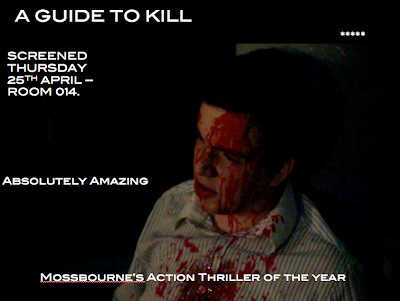
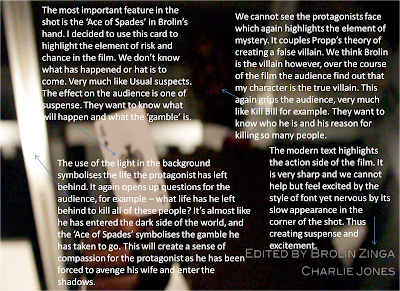


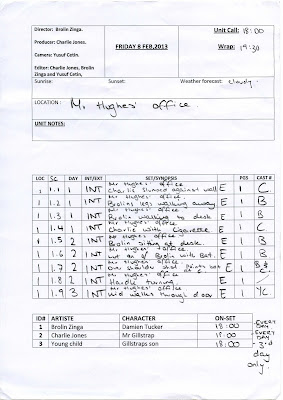


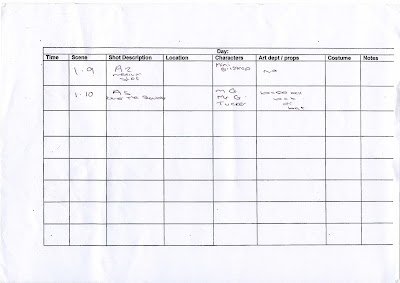






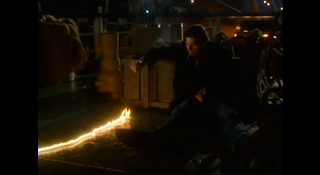
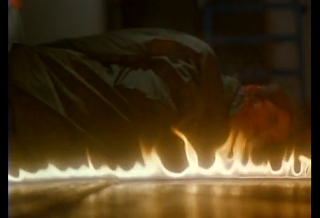

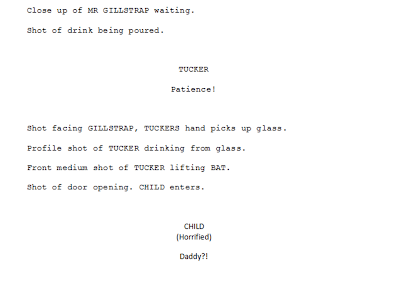
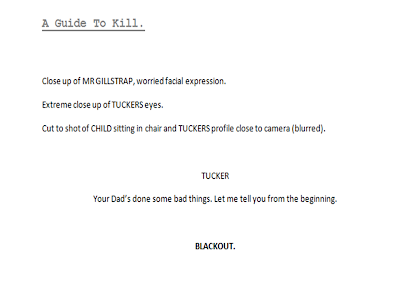
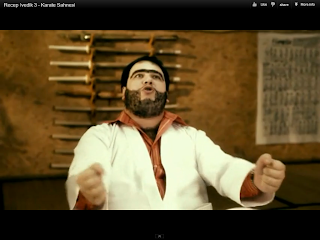




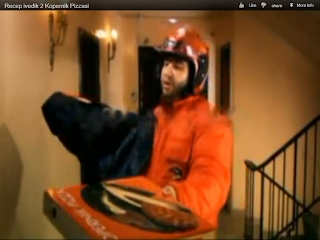

 Birds Eye view.
Birds Eye view.
 Eye Level.
Eye Level.





